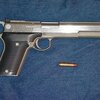Recently read the "Race to the Bottom" article about the 6mm ARC. Makes sense. 6mm ARC wouldn't exist without the rangefinder.
I've recently had a fascination with the side arm interchangeable cartridges. I guess first was 9mm (Mac-10), but more recently the 5.7x28mm. (Ruger LC carbine and pistol) I would also include the Keltec PMR-30, CMR-30 in 22WMR. I've also seen a 30 carbine pistol, but I don't think it had a matching carbine. But a common complaint is some aren't practical as self defense in a pistol.
So, the prompt is.... What is the most powerful cartridge that would work long range in a carbine, but also fit within a pistol grip? I think the max overall length would be around 1.68" the length of the 30 carbine. The AMT Automag III looked a little goofy, but lets assume it worked.
My vote is 6x35mm KAC (6mm-221, 6mm fireball, 6mm whisper) loaded with a snubby nosed bullet. (30-30 Leverevolution style) I think it could make the 1.68" length limit, and with a 65gr bullet at 2400fps in a pistol, it does a lot more damage than 5.7x28. In a 16" carbine I think it would be just behind 5.56 energy wise.
Also Sig is expanding it's ammunition of other cartridge's for their two-part case system. Maybe somewhere down the road there is a 6x35mm Fury that beats 5.56 out of a smaller package.



I've recently had a fascination with the side arm interchangeable cartridges. I guess first was 9mm (Mac-10), but more recently the 5.7x28mm. (Ruger LC carbine and pistol) I would also include the Keltec PMR-30, CMR-30 in 22WMR. I've also seen a 30 carbine pistol, but I don't think it had a matching carbine. But a common complaint is some aren't practical as self defense in a pistol.
So, the prompt is.... What is the most powerful cartridge that would work long range in a carbine, but also fit within a pistol grip? I think the max overall length would be around 1.68" the length of the 30 carbine. The AMT Automag III looked a little goofy, but lets assume it worked.
My vote is 6x35mm KAC (6mm-221, 6mm fireball, 6mm whisper) loaded with a snubby nosed bullet. (30-30 Leverevolution style) I think it could make the 1.68" length limit, and with a 65gr bullet at 2400fps in a pistol, it does a lot more damage than 5.7x28. In a 16" carbine I think it would be just behind 5.56 energy wise.
Also Sig is expanding it's ammunition of other cartridge's for their two-part case system. Maybe somewhere down the road there is a 6x35mm Fury that beats 5.56 out of a smaller package.







